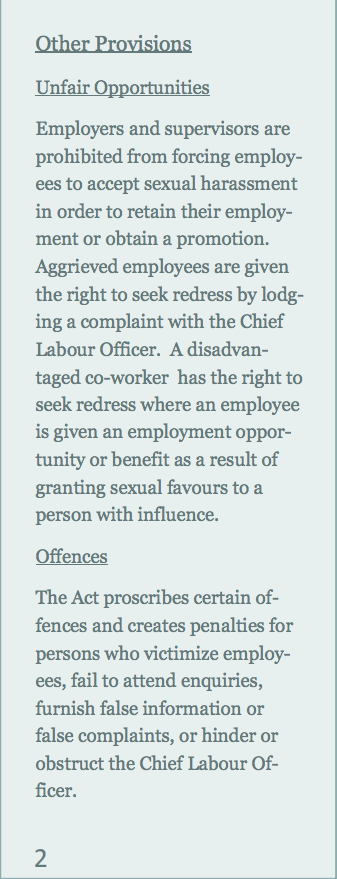The Employment Sexual Harassment (Prevention) Bill, 2017

WHAT YOU NEED TO KNOW.
The Employment Sexual Harassment (Prevention) Bill, 2017 revised on the 18th day of October 2017 was passed in the Senate on the 18th day of October 2017 and in the House of Assembly on the 7th day of November 2017. The Act came into operation the 15th day of December 2017.
This Bill’s stated objects are to make provision for the protection of employees in both the public sector and private sector from sexual harassment at their workplace; provide a framework for the reporting of sexual harassment cases by employees and a method of resolving such cases; establish a procedure for the hearing and determination of matters related to sexual harassment; and to provide for related matters.
DEFINITION OF SEXUAL HARASSMENT
Clause 3 provides a definition of “sexual harassment” so as to give guidance as to what would constitute sexual harassment. However, the definition is not exhaustive. For the purposes of this Act, sexual harassment includes (a) the use of sexually suggestive words, comments, jokes, gestures or actions that annoy, alarm or abuse a person; (b) the initiation of uninvited physical contact with a person; (c) the initiation of unwelcome sexual advances or the requests of sexual favours from a person; (d) asking a person intrusive questions that are of a sexual nature that pertain to that person’s private life; (e) transmitting sexually offensive writing or material of any kind; (f) making sexually offensive telephone calls to a person; or (g) any other sexually suggestive conduct of an offensive nature in circumstances where a reasonable person would consider the conduct to be offensive.
POLICY STATEMENT AGAINST SEXUAL HARASSMENT
The Act requires that all employers establish a policy statement against sexual harassment and to make the statement available to all employees. The statement must be consistent with the Act and in particular must contain the terms set out in the provisions of the Schedule.

CONTENT OF POLICY STATEMENT
The policy statement against sexual harassment must contain the following provisions: (a) a definition of sexual harassment; (b) a statement to the effect that every employee is entitled to employment free of sexual harassment; (c) a statement to the effect that the employer will make every reasonable effort to ensure that no employee is subjected to sexual harassment; (d) a statement to the effect that the employer will take such disciplinary measures as the employer deems appropriate against any person under the employer’s direction who subjects any employee to sexual harassment; (e) a statement explaining how complaints of sexual harassment may be brought to the attention of the employer; (f) a statement to the effect that no person shall disclose the name of a Complainant or the name of the respondent or the circumstances related to the complaint to any person except where disclosure is necessary for the purposes of investigating the complaint or taking disciplinary measures in relation thereto; and (g) a statement informing employees of the provisions in this Act which gives them a right to make a complaint and the relevant authority to whom the complaint must be made.
 LODGING OF COMPLAINTS
LODGING OF COMPLAINTS
An employee who desires to make a sexual harassment complaint against a coworker or a client of the employer may first lodge the complaint with their employer in order to give the employer an opportunity to resolve the matter. This complaint should be made within 3 months of the offensive conduct and should be made in writing.
The Act sets out the procedure that must be followed by an employer when a sexual harassment complaint is brought by an employee and requires an employer to take appropriate disciplinary action against an employee where investigations reveal that an employee has subjected a co-worker to sexual harassment.
If a Complainant is not satisfied with the employer’s findings, they may lodge a complaint in writing with the Chief Labour Officer within 3 months of the decision.
The Act also provides that where sexual harassment continues after a complaint has been made or after an employer has taken disciplinary action, the employee may seek relief by lodging a complaint with the Chief Labour Officer within 3 months.
There is provision for an employee to lodge a complaint directly with the Chief Labour Officer in circumstances where the complaint is against the employer of the Chief Executive Officer of an institution. Any complaint against the Chief Labour Officer is to be made directly to the Employment Tribunal.

DETERMINATION OF COMPLAINT BY THE C.L.O.
Where the Chief Labour Officer makes a finding that sexual harassment was committed by the Respondent, the Chief Labour Officer,
(a) may, where the Respondent is a co-worker, direct the employer, within a specified time, to take such disciplinary action as is appropriate in the circumstances;
(b) shall in all cases, direct the employer to take appropriate action, within a specified time, to ensure that the sexual harassment ceases; and
(c) May direct the employer to submit a report to him within a specified time on the status of the situation for any period of time.
Where the person is not satisfied with the decision of the Chief Labour Officer, that person may appeal to the Tribunal within 30 days of the date of the decision.
HEARING BY TRIBUNAL
The procedure for hearing complaints pursuant to the Employment Rights Act, 2012 (Act 2012- 19) applies where the complaints are to be determined by the Employment Rights Tribunal.
In circumstances where the Tribunal finds that a Respondent has engaged in conduct amounting to sexual harassment, the Tribunal is empowered by the Act to make declarations with respect to compensation to be awarded to the Complainant and costs, direct the employer to take appropriate action and direct the employer to submit a report.
Where the Complainant was dismissed from their employment as a result of their complaint, the Tribunal may take action in accordance with the Employment Rights Act.
Persons not satisfied by the decision of the Tribunal may appeal the decision within 30 days.
Download PDF: The Employment Sexual Harassment (Prevention) Bill, 2017


